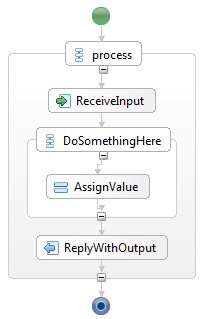Planning your Process
Now that you've taken a tour of the Process Designer, we can dive a little deeper into how to plan your new composite service and decide how to access the data your process will use.
The Process Design: Top-Down or Bottom Up?
When you design a process, the first step is to decided whether you will be creating a top-down or a bottom-up process. You can also design a process that combines both of these techniques.
| This technique | Looks like this... |
|---|---|
| Top-down | You build your process from scratch, by dropping activities from the palette onto the BPEL Editor process diagram. After you drag the activities to the editor, you then add the decision-making information and valid attributes that make the graphical process an actual working implementation. |
| Bottom-up | In this mode you use existing implementation definitions when you begin the process. When you use this technique you must use valid Web Services Description Language (WSDL) files. You can import WSDL and schema files in the Design Studio. |
| Combination | It is possible to start building a process with WSDL files that you've already imported into the design studio. You can enhance and modify the process using the BPEL Editor and activities. |
The Business Process
Before you can create a business process using BPEL, you need:
- An idea and business partner to exchange data with
- A plan (such as a flowchart) that describes how you want to receive data, map data in assignments, invoke operations, and reply to your business partner
- For a top-down process, WSDL definitions for each partner in the process that you will create for your process
- For a bottom-up process, WSDL files to import that describe the operations, messages, and properties that will be referenced by the process
The process is represented graphically in the BPEL Editor.

The BPEL process structure
In a BPEL process there is a beginning, a middle, and an end, which are all defined by BPEL activities.
- The beginning — The process always begins with a Receive or Pick (with an OnMessage event) activity.
- The middle — The middle of the process consists of activities, that can run either concurrently or in sequence.
- The end — The process ends when there are no more activities to run, a fault is thrown, or the Exit activity is encountered.
In the Design Studio, the process template contains a Receive activity and a Reply activity, as well as placeholder Sequence and Assign activities. You can modify, delete, or replace these activities.
Learn more about BPEL activites.
More Information: